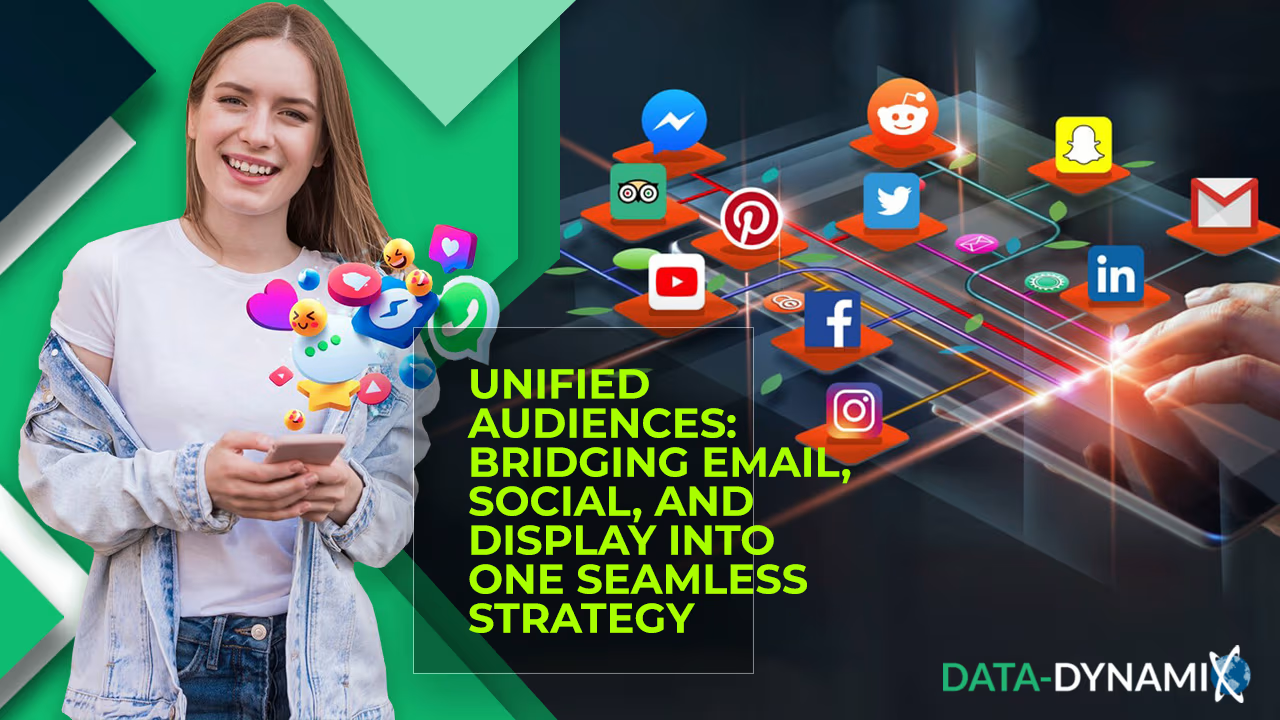In today’s fragmented marketing ecosystem, customers interact with your brand across dozens of touchpoints. They check emails on their phones, scroll social media during lunch breaks, and see display ads while browsing the web. If your messaging isn’t unified across these channels, your marketing feels disjointed—and your results suffer.
That’s why the future of effective campaign strategy lies in creating unified audiences—connected customer segments that flow across email, social, and display. When you bridge these channels into one seamless strategy, you not only improve reach and consistency but also boost engagement, reduce waste, and increase ROI.
In this blog, we’ll explore how to build and activate unified audiences, how to coordinate messaging across channels, and how Data Dynamix empowers agencies and marketers to deliver full funnel impact through synchronized multi channel strategies.
Why Unified Audiences Matter
Customers don’t think in channels—they think in experiences. But when marketing teams operate in silos, users receive:
- Repetitive or inconsistent messaging
- Mismatched offers on different platforms
- Missed opportunities to reinforce intent or drive action
A unified audience strategy solves this by:
- Creating a single source of truth about your customer
- Syncing audience definitions across platforms
- Ensuring consistent messaging based on where the customer is in the journey
- Improving campaign efficiency by reducing overlap and ad fatigue
When your audience strategy is unified, your brand feels smart, seamless, and customer centric.
What Are Unified Audiences?
Unified audiences are segments of users built using shared data sources and behavioral signals, which are then activated consistently across email, social media, and programmatic display advertising.
Rather than building separate lists for each channel, unified audiences are:
- Based on shared first party and third party data
- Synced and updated dynamically across platforms
- Enriched with cross channel behaviors like opens, clicks, page visits, and store visits
- Activated with personalized messages suited to each environment
What You Need to Build Unified Audiences
To implement a unified audience strategy, you need:
✅ A Centralized Data Source
This could be a CRM, a customer data platform (CDP), or a well structured audience management tool like the one offered by Data Dynamix. It should include:
- Email engagement data
- Website behavior
- Mobile activity
- Purchase and loyalty data
- Location and foot traffic insights
✅ Cross Channel Activation Capabilities
Once the audience is built, you must be able to push it to:
- Email platforms (ESP)
- Social ad platforms (Meta, LinkedIn, TikTok, etc.)
- Display networks or programmatic DSPs
✅ Real Time or Frequent Syncing
Audiences should update frequently to reflect new behaviors and avoid outdated targeting.
How to Bridge Email, Social, and Display into One Strategy
Let’s walk through how to activate unified audiences across all three channels in a synchronized funnel.
Step One: Define Your Audience Based on Real Behavior
Start with a meaningful behavior that indicates interest or intent.
Examples:
- Users who clicked a specific product link in an email
- Visitors who viewed your pricing page but didn’t convert
- Devices seen at your store or a competitor’s location
- Past purchasers eligible for cross sell campaigns
With Data Dynamix, you can build audience segments using both digital behaviors and real world foot traffic data—creating a richer, more precise profile.
Step Two: Sync the Audience Across Platforms
Once your segment is defined, push it into all relevant channels:
- Your ESP for personalized email
- Social ad platforms for custom audiences
- DSPs for display retargeting or prospecting
Pro tip: Use matching identifiers like email address or mobile ID to ensure users are recognized across platforms.
Step Three: Customize Messaging to the Channel and Funnel Stage
Even though the audience is unified, the content should be channel specific.
| Channel | Messaging Strategy |
| Personal, detailed, offer driven, triggered or nurtured sequences | |
| Social | Engaging visuals, social proof, shareable content, audience expansion |
| Display | High frequency, brand reinforcement, urgency, visual consistency |
All messaging should reflect the same offer, tone, and brand identity—but tailored to how the user interacts with each channel.
Step Four: Coordinate Timing and Frequency
Avoid overexposing your audience or serving them mixed messages. Set coordinated campaign timelines to manage when and where users see your ads.
Example Sequence:
- Day 1: Email sent with product promo
- Day 2–4: Social ad retargeting users who opened the email
- Day 5–7: Display ads for remaining users who didn’t convert
- Day 8: Second email with a time sensitive incentive
- Day 10+: Suppress converters from all platforms
This orchestrated flow ensures maximum relevance without message fatigue.
Real World Example: Unified Audience Campaign in Action
Client: Regional fitness chain launching a new membership offer
Audience:
- Past members who clicked on reactivation emails
- Visitors to gym locations in the past 30 days
- Website visitors to the pricing page
Execution:
- Email: Reactivation offer with personalized location information
- Social: Testimonial video ads targeting warm leads
- Display: Geo retargeting ads with “Join Today” message for in store visitors
Results:
- 5.6x return on ad spend
- 34 percent increase in reactivations
- 2.8x higher conversion rate from users reached on all three channels versus one
Takeaway: A synchronized message delivered across email, social, and display significantly improved performance.
How Data Dynamix Powers Unified Audience Campaigns
At Data Dynamix, we help marketers and agencies unify their audiences using:
✅ First party and third party data fusion
We combine your internal data with our consumer intent signals and mobile foot traffic data.
✅ Cross channel audience activation
Push unified audiences into your email system, DSP, and social ad accounts.
✅ Behavioral and location based targeting
Build audiences based on both digital actions and real world movement patterns.
✅ White labeled dashboards and reporting
Track unified performance across channels in one branded, client facing view.
✅ Real time attribution
See which combinations of email, social, and display drive real world actions like store visits and conversions.
Best Practices for Unified Audience Campaigns
✔️ Start with high intent segments—those who’ve already engaged digitally or physically
✔️ Ensure messaging consistency across channels while tailoring creative to each platform
✔️ Use suppression lists to avoid wasted impressions or confusing repeat messages
✔️ Test sequencing and timing to find your optimal message flow
✔️ Analyze combined performance, not just channel by channel
Final Thoughts
Unified audience marketing is no longer optional—it’s essential. When your audience sees a seamless experience across email, social, and display, your brand feels more relevant, more trustworthy, and more likely to drive action.
Stop thinking in channels. Start thinking in journeys. With the right data, the right tools, and the right strategy, you can turn fragmented engagement into orchestrated performance.
Ready to build a seamless cross channel strategy powered by unified audiences?
Partner with Data Dynamix to activate smarter segments, deliver consistent messaging, and prove real world results across email, social, and display.






